- Research Update: High-efficiency surface plasmon meta-couplers: concept and microwave-regime realizations
- Research Update: Spin Wave Diode
- Research Update: Tailor the Functionalities of Metasurfaces Based on a Complete Phase Diagram
- Research Update: Widely Tunable Terahertz Phase Modulation with Gate-Controlled Graphene Metasurfaces
- Research Update: Antiferromagnet also pumps spins
- 量子调控中心2013年学术委员会年会召开
- Research Update: Spin Hall effect predicted in metallic thin film
- Members of CQC elected new directors
Research Update: High-efficiency surface plasmon meta-couplers: concept and microwave-regime realizations
Prof. Lei Zhou's group realized high efficiency Surface plasmon polaritons coupler based on a transparent gradient metasurface, and this work is accepted by Light: Science and Application [link].
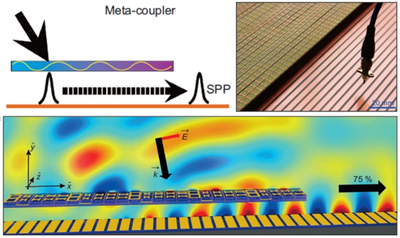
Surface plasmon polaritons (SPPs) and their low-frequency counterparts (i.e., spoof SPPs on artificial surfaces) have recently found numerous applications in photonics, but traditional devices to excite them (such as gratings and prism couplers) all suffer from problems of inherent low efficiency because the generated SPPs can decouple, returning to free space, and reflections at the device surface can never be avoided. Here, we propose a new SPP excitation scheme based on a transparent gradient metasurface and numerically demonstrate that it exhibits inherently high efficiency (~94%) because the designed meta-coupler suppresses both decoupling and surface reflections. As a practical realization of this concept, we fabricated a meta-coupler for operation in the microwave regime and performed near-field and far-field experiments to demonstrate that the achieved excitation efficiency for spoof SPPs reaches ~73%, which is several times higher than that achieved by other available devices in this frequency domain.
Our findings can motivate the design and fabrication of high-performance plasmonic devices to harvest light–matter interactions, particularly those related to spoof SPPs in the low-frequency domain.
Research Update: Spin Wave Diode
Prof. Jiang Xiao’s group their paper on spin wave diode published on Physical Review X [link]. This paper proposed a novel design of rewritable magnonics hardware architecture and demonstrated of a spin wave diode upon this design.
Magnonics is promising for the next generation energy-saving information technology and hence attracted increasing attention of broad researchers in recent years. The aim of magnonics is to achieve unified information storage and processing using magnons, or spin waves, which are collective quasi-particle excitations of the magnetic moments and can propagate without much energy dissipation. Quite many magnonic structures have been proposed and studied in all sorts of designs, however, a unified and scalable magnonic platform is still lacking.
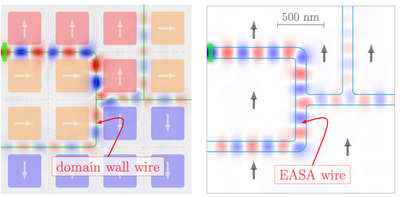
Using domain walls and surface anisotropy stripes as two different spin wave waveguides [see figure below], we propose a design of magnonic integrated circuits that can in principle perform large number of magnonic operations in a single magnetic wafer, analogy to a silicon wafer for large number of electronic transistors. Since the magnetic texture can be easily modified, this magnonic hardware architecture is reprogrammable, in contrast to most present-day information processing architectures.
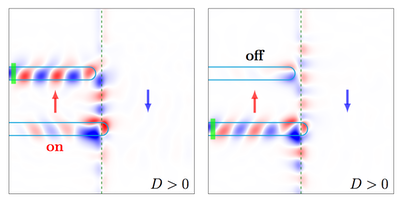 Upon this new architecture, we design the simplest magnonic component, a spin wave diode. Making use of the Dzyaloshiskii-Moriya interaction existing in magnetic materials with broken inversion symmetry, we found that the bound spin wave states in a domain wall become chiral and are spatially separated depending on its propagation direction, which enables us to realize the diode effect for spin wave transport [see figure below for the forward on and reverse off]. Furthermore, we demonstrate that the function of the spin wave diode is easily altered from forward-transmitting to reverse-transmitting, etc, by simply moving domain walls via current-induced spin-transfer torque. To our knowledge, this is the first viable design of spin wave diode.
Upon this new architecture, we design the simplest magnonic component, a spin wave diode. Making use of the Dzyaloshiskii-Moriya interaction existing in magnetic materials with broken inversion symmetry, we found that the bound spin wave states in a domain wall become chiral and are spatially separated depending on its propagation direction, which enables us to realize the diode effect for spin wave transport [see figure below for the forward on and reverse off]. Furthermore, we demonstrate that the function of the spin wave diode is easily altered from forward-transmitting to reverse-transmitting, etc, by simply moving domain walls via current-induced spin-transfer torque. To our knowledge, this is the first viable design of spin wave diode.
Research Update: Tailor the Functionalities of Metasurfaces Based on a Complete Phase Diagram
Prof. Lei Zhou and co-workers elucidate the tailor-ability on the functionality of metasurfaces in a metal-insulator-metal (MIM) configuration with theoretical and experimental demonstrations. The results has been recently published on Physical Review Letters [link].
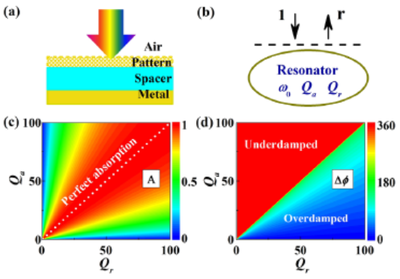
Metasurfaces in a MIM configuration have been widely used in photonics, with applications ranging from perfect absorption to phase modulation, but why and when such structures can realize what functionalities are not yet fully understood. Here, we combine theory and experiments to establish a generic phase diagram to understand the diversified functionalities discovered on MIM metasurfaces and provide practical approaches to tailor the functionalities of such systems. These generic results can guide people to design their own MIM metasurfaces with tailored and even tunable optical responses in different frequency domains. Our analyses also work in the high-frequency domain and for complex MIM structures supporting multiple resonances well separated in frequency. Our discoveries lay a solid basis for realizing functional and tunable photonic devices with such structures.
Research Update: Widely Tunable Terahertz Phase Modulation with Gate-Controlled Graphene Metasurfaces
The group of Prof. Lei Zhou realized widely tunable phase modulation with graphene metasurfaces, and the result is published on Physical Review X [link].
Holographic imaging relies on controlling the phase of electromagnetic waves, but conventional phase modulators are often large and expensive. Here, we demonstrate wide-range THz phase modulation with metasurfaces integrating magnetic resonators and gate-controlled grapheme, whose thicknesses are roughly one-tenth the wavelength of the incident radiation. We use a one-port resonator model to explain the essential features of the proposed metasurface, and we show that graphene is a gate-tunable loss material that can be used to modulate the critical transition in the resonator and achieve an extremely large phase modulation.
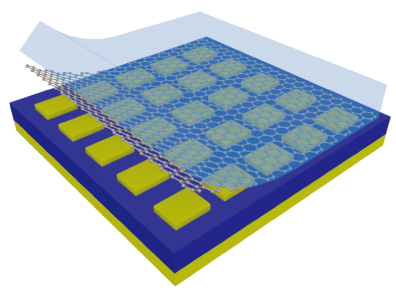
Previous efforts to modulate the phase of electromagnetic waves largely relied on changing the refractive index of materials or using a metasurface-based phase modulator; a drawback of the latter was that it could not be tuned remotely. Furthermore, many previous studies were only able to achieve phase modulation over a narrow range, which limited the applications of this technique. Here, we modulate the optical conductivity of graphene to change the phase of waves reflected off of the graphene metasurface. We employ a five-layer metasurface, and we change the resistance of the graphene by applying a voltage. We use spectroscopy to study both the amplitude and the phase of the electromagnetic radiation that is reflected, and we employ simulations to explore the physics of our technique. We are able to achieve phase modulation of 180 degrees, but we note that our results are susceptible to a reduction in reflectance (i.e., losses) that is due to absorption and radiation leakage. Finally, we use simulations to reproduce and support our experimental findings.
We expect that our findings will pave the way for other photonic applications in the THz regime.
Research Update: Antiferromagnet also pumps spins
Prof. Jiang Xiao and co-workers recently predicted that significant spin pumping is possible in antiferromagnet. The result has been recently published on Physical Review Letters [link].
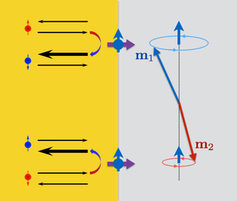 Spin pumping in ferromagnet is very well known. However, the spin pumping in antiferromagnet is generally believed to be vanishing because of the two compensating sublattices. This simple thinking is actually wrong. In this paper, we argue that the spin pumping from the two compensating sublattice actually constructively enhance each other instead of cancelling. The reason is that, at antiferromagnet resonance, the magnetizations of the two sublattices are in fact precessing in the same direction (with a pi phase difference).
Spin pumping in ferromagnet is very well known. However, the spin pumping in antiferromagnet is generally believed to be vanishing because of the two compensating sublattices. This simple thinking is actually wrong. In this paper, we argue that the spin pumping from the two compensating sublattice actually constructively enhance each other instead of cancelling. The reason is that, at antiferromagnet resonance, the magnetizations of the two sublattices are in fact precessing in the same direction (with a pi phase difference).
The spin pumping current by AFM written in terms of the net magnetization m and Neel order parameter n is:
![]()
Due to the very high resonance frequency (THz) of AFM dynamics, the AFM spin pumping current can be much larger than that of FM (GHz), assuming that both dynamics have similar precession cone angle.
量子调控中心2013年学术委员会年会召开
复旦大学量子调控中心于2013年11月30日(周六)举办了2013年学术委员会年会。参加会议的有8位来自兄弟院校及研究所的学术委员会委员以及中心大部分成员。年会上,由中心共同主任之一龚新高介绍了中心总体情况,并由周磊、陈焱、向红军、肖江做了专题报告。
会议上正式聘请了以下专家为新一届的中心学术委员会委员:于渌(委员会主任)、邢定钰、朱邦芬、孙昌璞、向涛、张振宇、张富春、王玉鹏、陶瑞宝、孙鑫、薛其坤、谢心澄、王恩哥、陈子亭、林海清、赵忠贤。本次会议除了薛其坤、谢心澄、王恩哥由于时间原因未能参加外,其余委员均参加了本次年会并对中心发展提出了宝贵意见。
Research Update: Spin Hall effect predicted in metallic thin film
Prof. Jiang Xiao and co-workers recently predicted that it is possible to conceive spin Hall effect in metallic thin films sandwiched by insulators without using nobel metals (such as Au or Pt), which is usually thought to be necessary for spin Hall effect. The result is published on Physical Review B 87, 081407(R) (2013) (Rapid Communications).
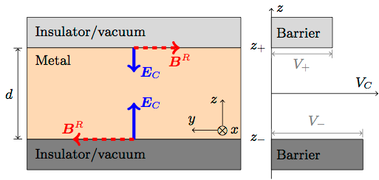
When a normal metallic thin film (without bulk spin-orbit coupling, such as Cu or Al) is sandwiched by two insulators (see right figure), interfacial spin-orbit coupling appears due to the gradient in the confining potenital, which then subsequently induces two prominent effects: 1) a giant spin-Hall effect due to the surface scattering as mentioned above, and 2) a transverse electric polarization due to the spin-dependent phase shift in the spinor wave functions.
The spin Hall effect and its inverse effect are essential in generating and detecting spin current in the spintronic applications. The sandwich-type structure proposed in this paper has the potential application to replace noble metals (such as Pt) as a source and detector for spin currents.
Members of CQC elected new directors
Because of the end of Prof. Jianqian You's term as CQC director, on Jan. 10th, the members of CQC elected two new directors: Prof. Xinggao Gong and Prof. Lei Zhou, who will share the burden as the directors of CQC.
Prof. Gong and Prof. Zhou appointed Prof. Jiang Xiao as vice-director for coordinating CQC affairs.
